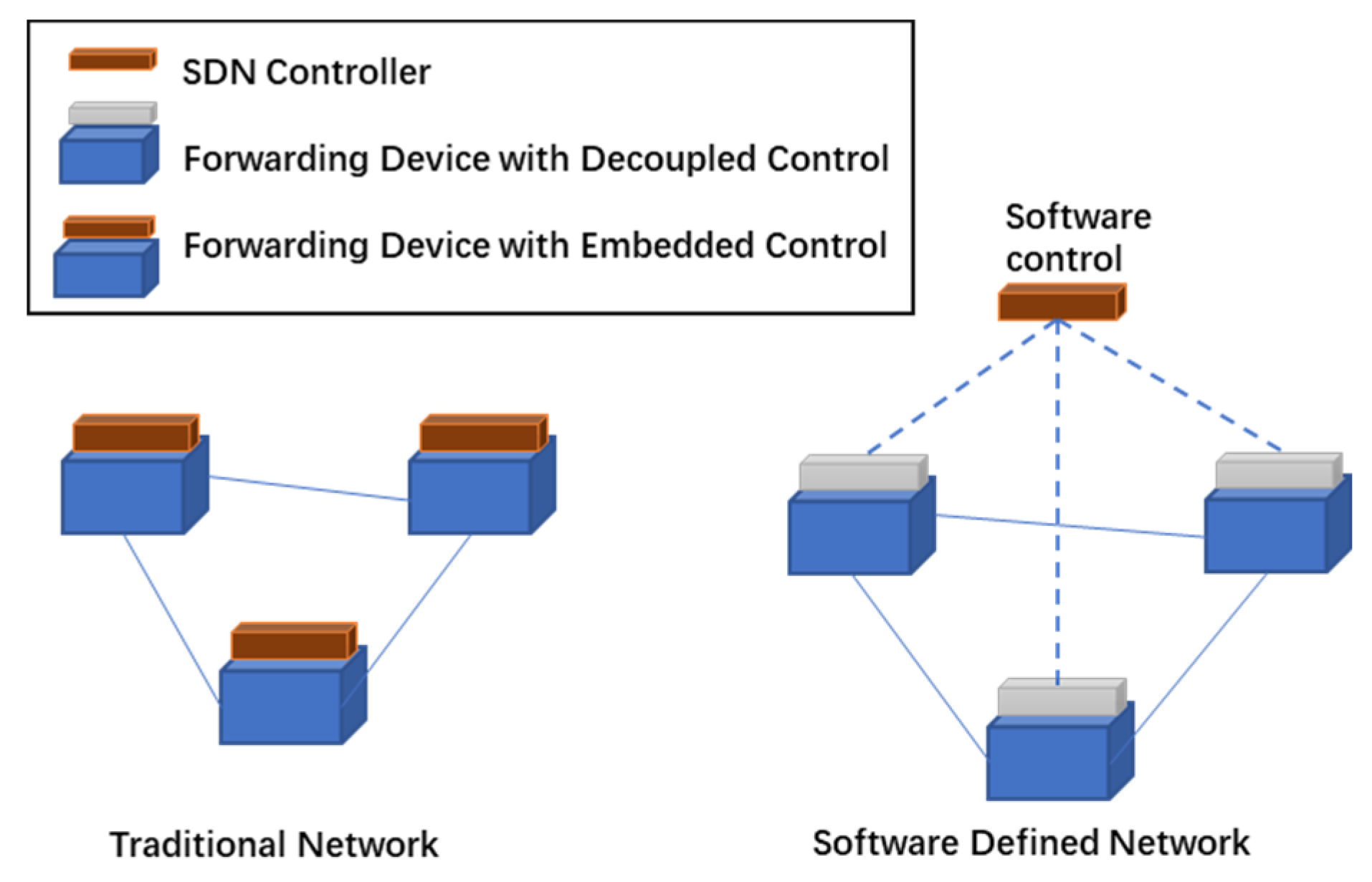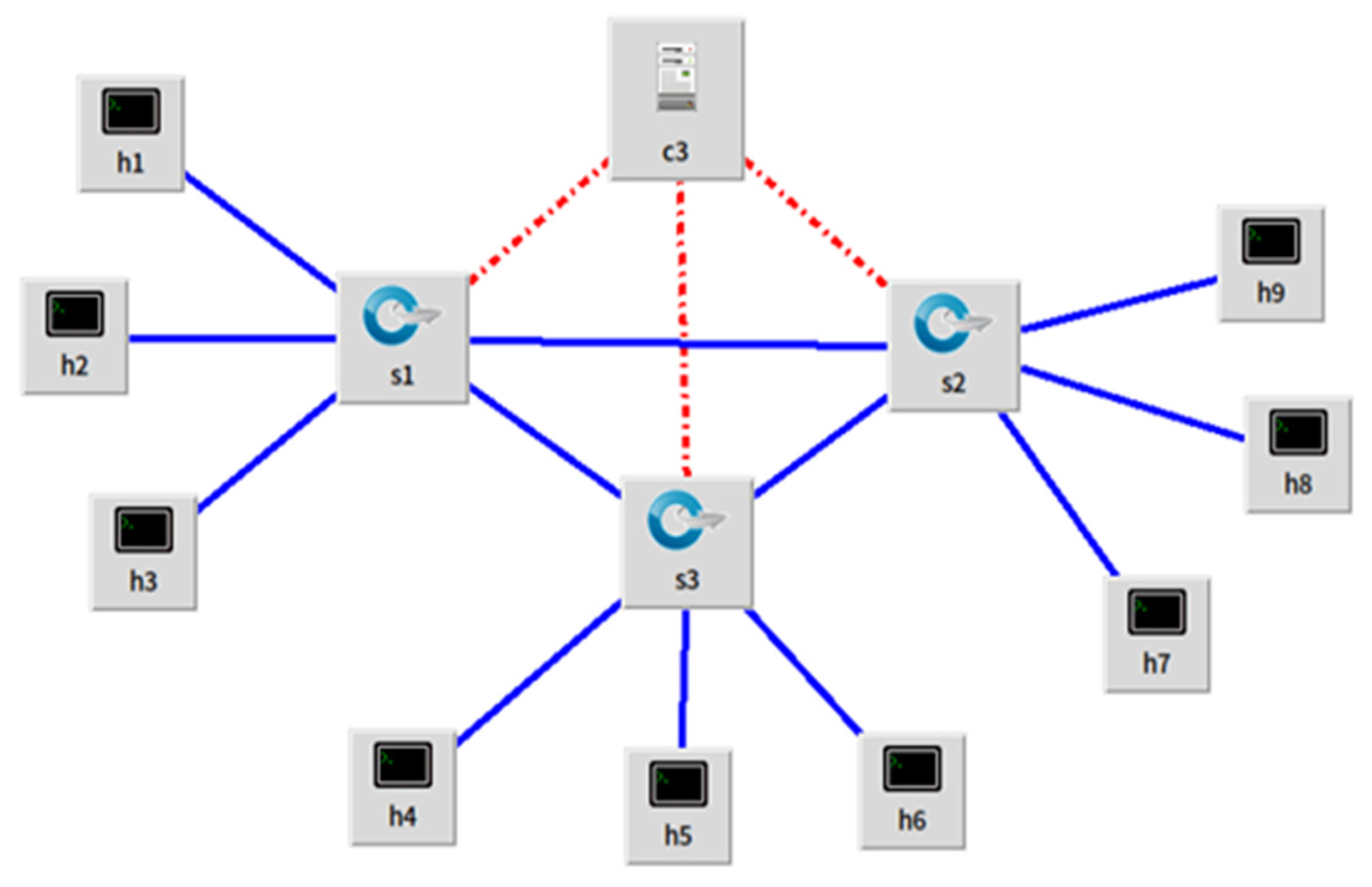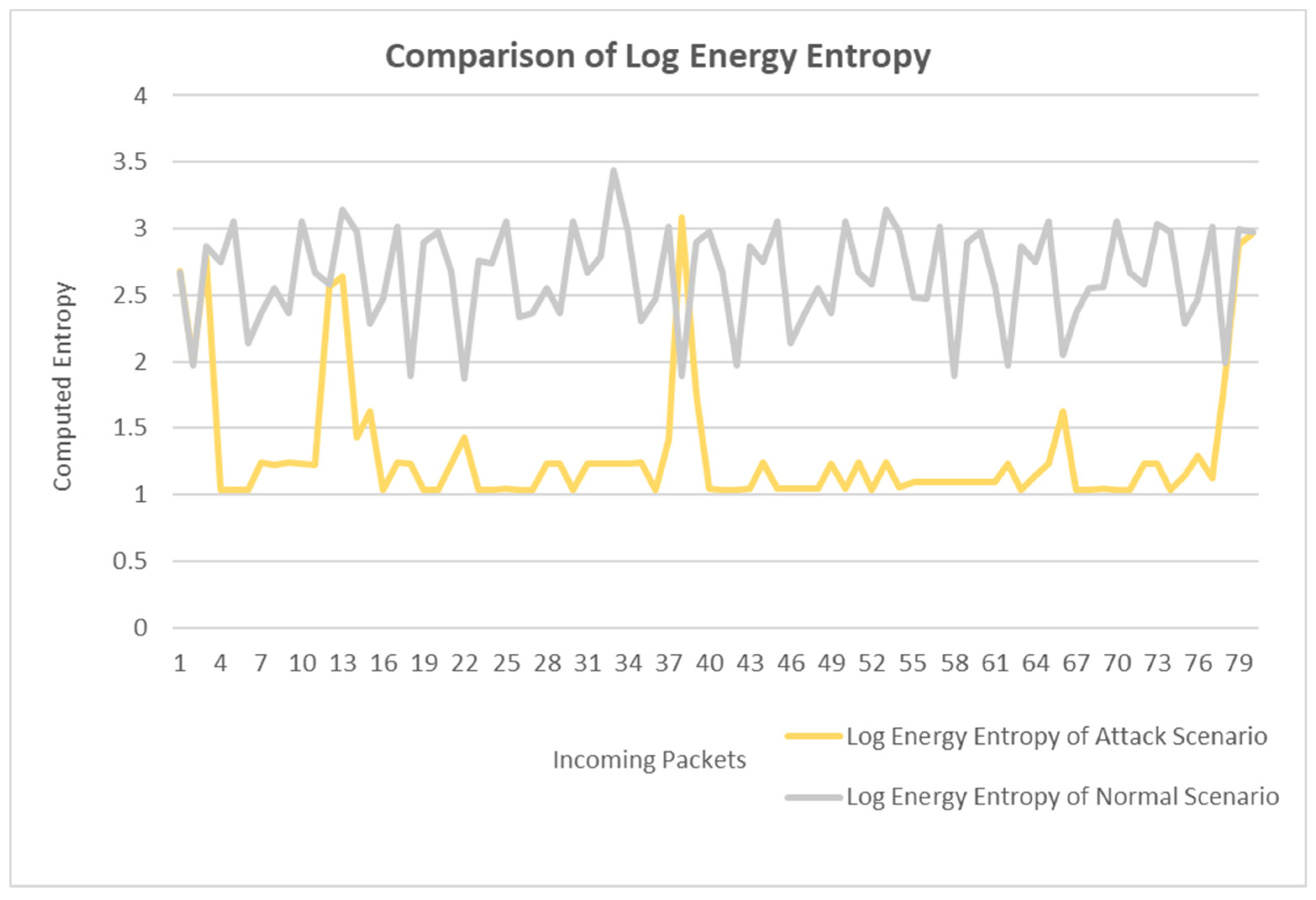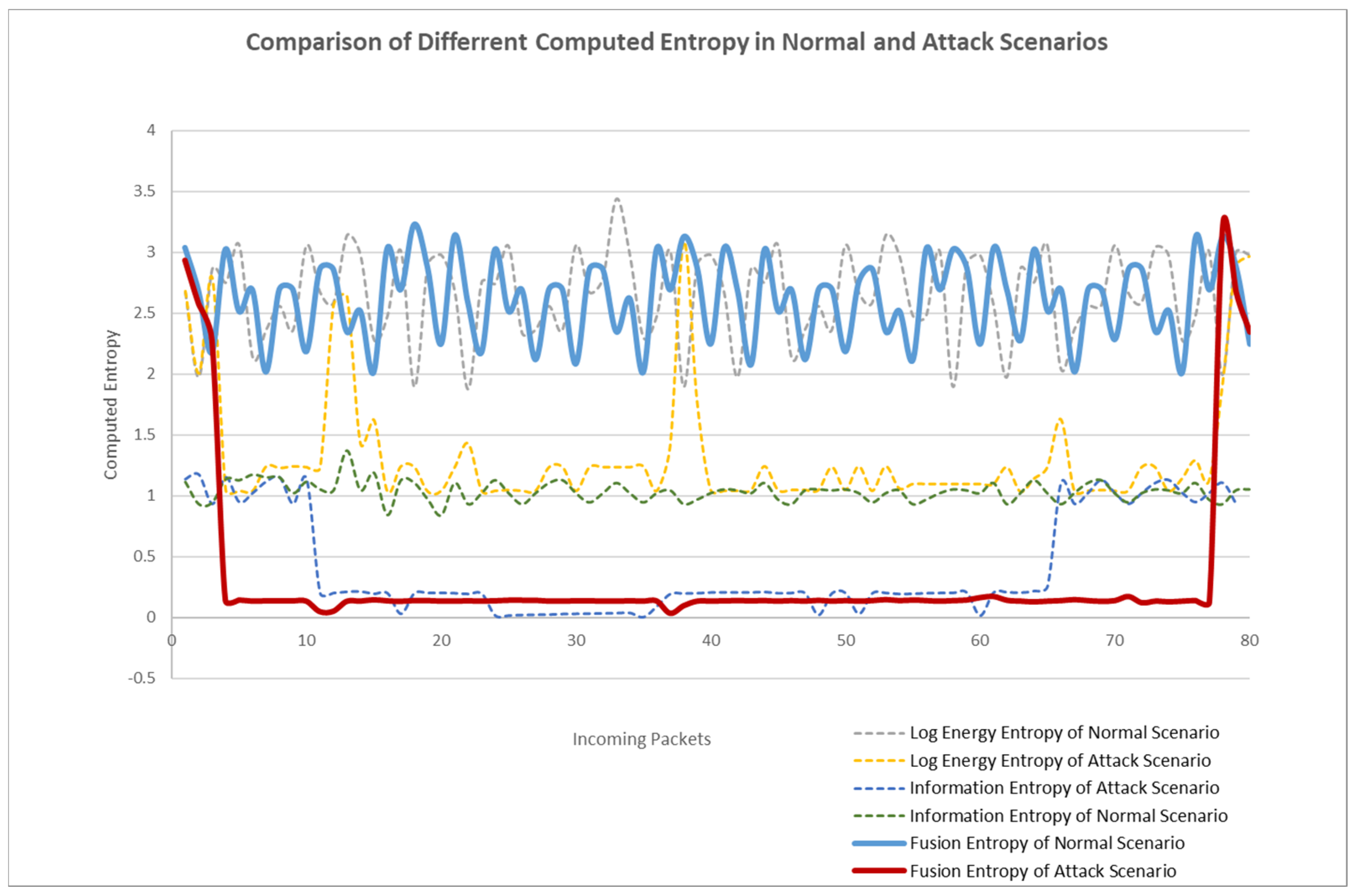Detection of DDoS Attacks in Software Defined Networking Using Entropy
Abstract
:Featured Application
Abstract
1. Introduction
- Application threats: Applications implemented on the control plane may seriously threaten the security of the control plane.
- Scalability Threats: Due to lack of scalability, the control plane gradually becomes saturated and cannot handle more flows [6].
- DDoS attack: Controllers are vulnerable to DDoS attacks [7]. When receiving a packet, the switch matches the packet with the flow table entry. If the packet fails to match, the switch encapsulates the packet header into a packet_in message and sends the packet to the controller. When an attacker sends a large number of packets to the network, the switch forwards these packets to the controller. A large number of DDoS spoofing packets exhaust controller resources and make the controller unable to work properly, posing serious threats to the controller and the entire network.
- Other threats: Inconsistent and conflicting controller configurations may result in failure to receive network information [8]. Malicious applications can easily be developed to apply to controllers. There is no effective trust management mechanism between controller and application.
2. Related Works
2.1. Software Defined Networking
2.2. Analysis of Threats over SDN Network
- The lack of security protection mechanism makes the controller in a potential threat;
- Complex interactions between various applications increase the burden of flow rules;
- Lack of authentication mechanism and application authorization;
- There is not enough secure encryption for the flow rules, making it easy for the flow rules to be tampered with after publication.
2.3. Distributed Denial of Service in SDN
3. Proposed Work
3.1. Fusion Entropy
3.2. Packet Generation
3.3. Window Size
4. DDoS Attacks Detection on Simulated SDN Network
4.1. Experiment Environment Setup
4.2. Pox Controller
5. Experimental Results and Discussion
6. Conclusions
Author Contributions
Funding
Institutional Review Board Statement
Informed Consent Statement
Data Availability Statement
Conflicts of Interest
References
- Al-Adaileh, M.A.; Anbar, M.; Chong, Y.W.; Al-Ani, A. Proposed statistical-based approach for detecting distribute denial of service against the controller of software defined network (SADDCS). In MATEC Web of Conferences; EDP Sciences: Les Ulis, France, 2018; Volume 218, p. 02012. [Google Scholar]
- Sanjeetha, R.; Srivastava, S.; Pokharna, R.; Shafiq, S.; Kanavalli, A. Mitigation of DDoS attack instigated by compromised switches on SDN controller by analyzing the flow rule request traffic. Int. J. Eng. Technol. (UAE) 2018, 7, 46–49. [Google Scholar]
- Mladenov, B.; Iliev, G. Searching for Optimal Software Defined Network Controller Against DDoS Attacks. In Proceedings of the 2020 International Symposium on Networks, Computers and Communications (ISNCC), Montreal, QC, Canada, 20–22 October 2020; IEEE: Piscataway, NJ, USA, 2020; pp. 1–4. [Google Scholar]
- Sanjeetha, R.; Benoor, P.; Kanavalli, A. Mitigation of DDoS attacks in Software Defined Networks at application level. In Proceedings of the 2019 PhD Colloquium on Ethically Driven Innovation and Technology for Society (PhD EDITS), Bangalore, India, 18 August 2019; IEEE: Piscataway, NJ, USA, 2019; pp. 1–3. [Google Scholar]
- Zhao, Y.; Iannone, L.; Riguidel, M. On the performance of SDN controllers: A reality check. In Proceedings of the 2015 IEEE Conference on Network Function Virtualization and Software Defined Network (NFV-SDN), San Francisco, CA, USA, 18–21 November 2015; IEEE: Piscataway, NJ, USA, 2015; pp. 79–85. [Google Scholar]
- Nanda, S.; Zafari, F.; DeCusatis, C.; Wedaa, E.; Yang, B. Predicting network attack patterns in SDN using machine learning approach. In Proceedings of the 2016 IEEE Conference on Network Function Virtualization and Software Defined Networks (NFV-SDN), Palo Alto, CA, USA, 7–10 November 2016; IEEE: Piscataway, NJ, USA, 2016; pp. 167–172. [Google Scholar]
- Dong, S.; Sarem, M. DDoS attack detection method based on improved KNN with the degree of DDoS attack in software-defined networks. IEEE Access 2019, 8, 5039–5048. [Google Scholar] [CrossRef]
- Gkountis, C.; Taha, M.; Lloret, J.; Kambourakis, G. Lightweight algorithm for protecting SDN controller against DDoS attacks. In Proceedings of the 2017 10th IFIP Wireless and Mobile Networking Conference (WMNC), Valencia, Spain, 25–27 September 2017; IEEE: Piscataway, NJ, USA, 2017; pp. 1–6. [Google Scholar]
- Dong, P.; Du, X.; Zhang, H.; Xu, T. A detection method for a novel DDoS attack against SDN controllers by vast new low-traffic flows. In Proceedings of the 2016 IEEE International Conference on Communications (ICC), Kuala Lumpur, Malaysia, 22–27 May 2016; IEEE: Piscataway, NJ, USA, 2016; pp. 1–6. [Google Scholar]
- Ferrag, M.A.; Maglaras, L.; Moschoyiannis, S.; Janicke, H. Deep learning for cyber security intrusion detection: Approaches, datasets, and comparative study. J. Inf. Secur. Appl. 2020, 50, 102419. [Google Scholar] [CrossRef]
- Bouras, C.; Kollia, A.; Papazois, A. SDN & NFV in 5G: Advancements and challenges. In Proceedings of the 2017 20th Conference on innovations in clouds, internet and networks (ICIN), Paris, France, 7–9 March 2017; IEEE: Piscataway, NJ, USA, 2017; pp. 107–111. [Google Scholar]
- Kreutz, D.; Ramos, F.M.; Verissimo, P.E.; Rothenberg, C.E.; Azodolmolky, S.; Uhlig, S. Software-defined networking: A comprehensive survey. Proc. IEEE 2014, 103, 14–76. [Google Scholar] [CrossRef] [Green Version]
- Gangadhara, S.; Hasyagar, S.N.; Damotharan, U. Deployable SDN architecture for network applications: An investigative survey. In Proceedings of the 2019 5th International Conference on Advanced Computing & Communication Systems (ICACCS), Coimbatore, India, 15–16 March 2019; IEEE: Piscataway, NJ, USA, 2019; pp. 43–49. [Google Scholar]
- Hatagundi, M.D.; Kumaraswamy, H.V. A comprehensive survey on different attacks on SDN and approaches to mitigate. In Proceedings of the 2019 3rd International Conference on Computing Methodologies and Communication (ICCMC), Erode, India, 27–29 March 2019; IEEE: Piscataway, NJ, USA, 2019; pp. 624–627. [Google Scholar]
- Yadav, S.K.; Suguna, P.; Velusamy, R.L. Entropy based mitigation of Distributed-Denial-of-Service (DDoS) attack on Control Plane in Software-Defined-Network (SDN). In Proceedings of the 2019 10th International Conference on Computing, Communication and Networking Technologies (ICCCNT), Kanpur, India, 6–8 July 2019; IEEE: Piscataway, NJ, USA, 2019; pp. 1–7. [Google Scholar]
- Jiménez, M.B.; Fernández, D.; Rivadeneira, J.E.; Bellido, L.; Cárdenas, A. A Survey of the Main Security Issues and Solutions for the SDN Architecture. IEEE Access 2021, 9, 122016–122038. [Google Scholar] [CrossRef]
- Kaur, G.; Gupta, P. Hybrid approach for detecting ddos attacks in software defined networks. In Proceedings of the 2019 Twelfth International Conference on Contemporary Computing (IC3), Noida, India, 8–10 August 2019; IEEE: Piscataway, NJ, USA, 2019; pp. 1–6. [Google Scholar]
- Liu, Y.; Zhao, B.; Zhao, P.; Fan, P.; Liu, H. A survey: Typical security issues of software-defined networking. China Commun. 2019, 16, 13–31. [Google Scholar] [CrossRef]
- Ahmad, I.; Namal, S.; Ylianttila, M.; Gurtov, A. Security in software defined networks: A survey. IEEE Commun. Surv. Tutor. 2015, 17, 2317–2346. [Google Scholar] [CrossRef]
- Melkov, D.; Paulikas, S. Security Benefits and Drawbacks of Software-Defined Networking. In Proceedings of the 2021 IEEE Open Conference of Electrical, Electronic and Information Sciences (eStream), Vilnius, Lithuania, 22 April 2021; IEEE: Piscataway, NJ, USA, 2021; pp. 1–4. [Google Scholar]
- Cox, J.H.; Chung, J.; Donovan, S.; Ivey, J.; Clark, R.J.; Riley, G.; Owen, H.L. Advancing software-defined networks: A survey. IEEE Access 2017, 5, 25487–25526. [Google Scholar] [CrossRef]
- Aladaileh, M.A.; Anbar, M.; Hasbullah, I.H.; Chong, Y.W.; Sanjalawe, Y.K. Detection techniques of distributed denial of service attacks on software-defined networking controller—A review. IEEE Access 2020, 8, 143985–143995. [Google Scholar] [CrossRef]
- Deore, S.; Patil, A. Survey denial of service classification and attack with protect mechanism for TCP SYN flooding attacks. IRJET 2016, 3, 1–4. [Google Scholar]
- Rajkumar, M.N. A survey on latest DoS attacks: Classification and defense mechanisms. Int. J. Innov. Res. Comput. Commun. Eng. 2013, 1, 1847–1860. [Google Scholar]
- Boite, J.; Nardin, P.A.; Rebecchi, F.; Bouet, M.; Conan, V. Statesec: Stateful monitoring for DDoS protection in software defined networks. In Proceedings of the 2017 IEEE Conference on Network Softwarization (NetSoft), Bologna, Italy, 3–7 July 2017; IEEE: Piscataway, NJ, USA, 2017; pp. 1–9. [Google Scholar]
- Huang, X.; Du, X.; Song, B. An effective DDoS defense scheme for SDN. In Proceedings of the 2017 IEEE International Conference on Communications (ICC), Paris, France, 21–25 May 2017; IEEE: Piscataway, NJ, USA, 2017; pp. 1–6. [Google Scholar]
- Kumar, P.; Tripathi, M.; Nehra, A.; Conti, M.; Lal, C. SAFETY: Early detection and mitigation of TCP SYN flood utilizing entropy in SDN. IEEE Trans. Netw. Serv. Manag. 2018, 15, 1545–1559. [Google Scholar] [CrossRef]
- Sambandam, N.; Hussein, M.; Siddiqi, N.; Lung, C.H. Network security for iot using sdn: Timely ddos detection. In Proceedings of the 2018 IEEE Conference on Dependable and Secure Computing (DSC), Kaohsiung, Taiwan, 10–13 December 2018; IEEE: Piscataway, NJ, USA, 2018; pp. 1–2. [Google Scholar]
- Sadiq, M.T.; Yu, X.; Yuan, Z.; Aziz, M.Z. Motor imagery BCI classification based on novel two-dimensional modelling in empirical wavelet transform. Electron. Lett. 2020, 56, 1367–1369. [Google Scholar] [CrossRef]
- Sadiq, M.T.; Yu, X.; Yuan, Z.; Fan, Z.; Rehman, A.U.; Li, G.; Xiao, G. Motor imagery EEG signals classification based on mode amplitude and frequency components using empirical wavelet transform. IEEE Access 2019, 7, 127678–127692. [Google Scholar] [CrossRef]
- Sadiq, M.T.; Yu, X.; Yuan, Z.; Zeming, F.; Rehman, A.U.; Ullah, I.; Li, G.; Xiao, G. Motor imagery EEG signals decoding by multivariate empirical wavelet transform-based framework for robust brain–computer interfaces. IEEE Access 2019, 7, 171431–171451. [Google Scholar] [CrossRef]
- Sadiq, M.T.; Yu, X.; Yuan, Z. Exploiting dimensionality reduction and neural network techniques for the development of expert brain–computer interfaces. Expert Syst. Appl. 2021, 164, 114031. [Google Scholar] [CrossRef]
- Liu, Y.; Yin, J.; Cheng, J.; Zhang, B. Detecting DDoS attacks using conditional entropy. In Proceedings of the 2010 International Conference on Computer Application and System Modeling (ICCASM 2010), Taiyuan, China, 22–24 October 2010; IEEE: Piscataway, NJ, USA, 2010; Volume 13, V13-278–V13-282. [Google Scholar]
- Ahuja, N.; Singal, G. DDoS attack detection & prevention in SDN using OpenFlow statistics. In Proceedings of the 2019 IEEE 9th International Conference on Advanced Computing (IACC), Tiruchirappalli, India, 13–14 December 2019; IEEE: Piscataway, NJ, USA, 2019; pp. 147–152. [Google Scholar]
- You, X.; Feng, Y.; Sakurai, K. Packet in message based DDoS attack detection in SDN network using OpenFlow. In Proceedings of the 2017 Fifth International Symposium on Computing and Networking (CANDAR), Aomori, Japan, 19–22 November 2017; IEEE: Piscataway, NJ, USA, 2017; pp. 522–528. [Google Scholar]
- Alzahrani, S.; Hong, L. Detection of distributed denial of service (DDoS) attacks using artificial intelligence on cloud. In Proceedings of the 2018 IEEE World Congress on Services (SERVICES), San Francisco, CA, USA, 2–7 July 2018; IEEE: Piscataway, NJ, USA, 2018; pp. 35–36. [Google Scholar]
- Sun, W.; Li, Y.; Guan, S. An improved method of DDoS attack detection for controller of SDN. In Proceedings of the 2019 IEEE 2nd International Conference on Computer and Communication Engineering Technology (CCET), Beijing, China, 16–18 August 2019; IEEE: Piscataway, NJ, USA, 2019; pp. 249–253. [Google Scholar]
- Sumantra, I.; Gandhi, S.I. DDoS attack Detection and Mitigation in Software Defined Networks. In Proceedings of the 2020 International Conference on System, Computation, Automation and Networking (ICSCAN), Pondicherry, India, 3–4 July 2020; IEEE: Piscataway, NJ, USA, 2020; pp. 1–5. [Google Scholar]







| Controller | Language | Openflow | Thread | Release |
|---|---|---|---|---|
| Ryu | Python | 1.0~1.4 | Single | 03/2015 |
| Pox | Python | 1.0 | Single | 10/2013 |
| Nox | C++ | 1.0&1.3 | Multiple | 02/2014 |
| Beacon | Java | 1.0 | Multiple | 09/2013 |
| Floodlight | Java | 1.0 | Multiple | 11/2012 |
| Opendaylight | Java | 1.0&1.3 | / | 03/2015 |
| ONOS | Java | 1.0&1.3 | / | 03/2015 |
| Information Entropy | Incoming Packets | |
|---|---|---|
| Normal | Attack | |
| 1.11439 | 1.13712 | 1 |
| 1.1174 | 1.13712 | 10 |
| 0.84288 | 0.20198 | 20 |
| 1.0235 | 0.02878 | 30 |
| 1.0235 | 0.20452 | 40 |
| 1.05419 | 0.20017 | 50 |
| 1.0235 | 0.01419 | 60 |
| 1.0235 | 1.0235 | 70 |
| 0.84288 | 1.10643 | 80 |
| Log Energy Entropy | Incoming Packets | |
|---|---|---|
| Normal | Attack | |
| 2.66956 | 2.67964 | 1 |
| 3.05772 | 1.23388 | 10 |
| 2.97717 | 1.0398 | 20 |
| 3.05772 | 1.0398 | 30 |
| 2.97717 | 1.04654 | 40 |
| 3.05772 | 1.04654 | 50 |
| 2.97717 | 1.09536 | 60 |
| 3.05772 | 1.0398 | 70 |
| 2.97717 | 2.96453 | 80 |
| Fusion Entropy | Incoming Packets | |
|---|---|---|
| Normal | Attack | |
| 3.03872 | 2.93872 | 1 |
| 2.18832 | 0.13869 | 10 |
| 2.25056 | 0.13869 | 20 |
| 2.08832 | 0.1411 | 30 |
| 2.25056 | 0.13869 | 40 |
| 2.18832 | 0.14284 | 50 |
| 2.25056 | 0.16812 | 60 |
| 2.28832 | 0.14284 | 70 |
| 2.25056 | 2.35056 | 80 |
Publisher’s Note: MDPI stays neutral with regard to jurisdictional claims in published maps and institutional affiliations. |
© 2021 by the authors. Licensee MDPI, Basel, Switzerland. This article is an open access article distributed under the terms and conditions of the Creative Commons Attribution (CC BY) license (https://creativecommons.org/licenses/by/4.0/).
Share and Cite
Fan, C.; Kaliyamurthy, N.M.; Chen, S.; Jiang, H.; Zhou, Y.; Campbell, C. Detection of DDoS Attacks in Software Defined Networking Using Entropy. Appl. Sci. 2022, 12, 370. https://doi.org/10.3390/app12010370
Fan C, Kaliyamurthy NM, Chen S, Jiang H, Zhou Y, Campbell C. Detection of DDoS Attacks in Software Defined Networking Using Entropy. Applied Sciences. 2022; 12(1):370. https://doi.org/10.3390/app12010370
Chicago/Turabian StyleFan, Cong, Nitheesh Murugan Kaliyamurthy, Shi Chen, He Jiang, Yiwen Zhou, and Carlene Campbell. 2022. "Detection of DDoS Attacks in Software Defined Networking Using Entropy" Applied Sciences 12, no. 1: 370. https://doi.org/10.3390/app12010370
APA StyleFan, C., Kaliyamurthy, N. M., Chen, S., Jiang, H., Zhou, Y., & Campbell, C. (2022). Detection of DDoS Attacks in Software Defined Networking Using Entropy. Applied Sciences, 12(1), 370. https://doi.org/10.3390/app12010370






